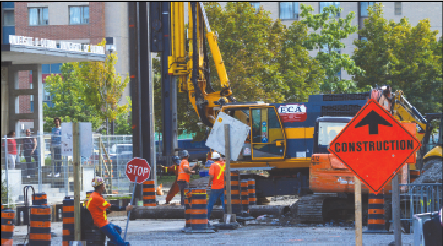LRT construction continues, OC Transpo still negotiating age cap
Lindsay Macmillan | Fulcrum Contributor
OTTAWA’S PUBLIC TRANSIT will be hectic until 2018, according to Mayor Jim Watson.
This year’s university move-in weekend will provide new and returning students with first-hand experience of the discord expected in the downtown core with the construction of the new Light Rail Transit (LRT) line.
Anne-Marie Roy, president of the Student Federation of the University of Ottawa (SFUO), warned new residents that three quarters of the 90 University Priv. parking lot is obstructed by the construction, likely causing an overflow of people for move-in. Her main concern for 101 Week is whether or not new students and their parents will be able to find the residences.
“When you get off the 417, you are no longer able to turn right on Laurier, which is going to mean that when students are moving into residence, they’re going to have to take detours downtown,” said Roy. “Rideau Street also has construction, so going east there will likely be traffic flooding into Sandy Hill.”
According to Kaitlynne Landry, president of the Residents’ Association of the University of Ottawa (RAUO), her biggest concern is “the long–term effect of the construction: the noise and dust pollution.”
For move-in days, she assured that the Residence Resource Centre will keep traffic moving thanks to their volunteers managing “traffic control, parking, and even helping new residents move in.”
All new residents have been mailed cards with a specific date and time for moving to prevent an overflow of traffic.
The SFUO has been meeting weekly to devise systems to prevent interference with the rest of 101 Week. Likewise, the RAUO will ensure the residences remain ideal places to sleep and study. Housing Service has also extended move-in by one day to try to alleviate the pressure caused by the construction.
Mayor Watson called the LRT construction “classic short-term pain for long-term gain.” With the completion of the LRT, mobility of students at the U of O will increase, allowing students who live farther from campus to get there quickly.
The U of O is one of the central stops of the 13 stations on the line, running east–west from Blair to Tunney’s Pasture. The LRT will also include an underground portion through much of the downtown core in order to alleviate the traffic on Slater Street and Albert Street during peak hours.
Watson said the first phase of the LRT will cost $2.1 billion, and is the biggest construction project in Ottawa’s history, comparable to the construction of the Rideau Canal. He said construction will be complete by 2017, and will be in operation by the first quarter of 2018.
According to mayor Watson, although the station names are still up for negotiation, they will likely remain the same as their bus counterparts. The stop at LeBreton may however be called Pimisi, and there will be a Rideau Centre stop named either Rideau or Parliament. A city document presented to the Transit Commission offers the possible names but a decision has not been made.
Until the completion of the LRT, students will rely on buses and the O-Train. Full-time students get a U-Pass, which is included in tuition fees and provides unlimited service from September to April. The U-Pass will also include the LRT after its completion.
Currently, the U of O, St Paul’s University, and Carleton University are part of the U-Pass program, and discussions are ongoing with Algonquin College and La Cité collégiale.
“OC Transpo and the Transit Commission are strong supporters of extending the U-Pass,” said City Councillor and chairperson of the City of Ottawa Transit Commission Diane Deans in an email. “It would be a great success for the Transit Commission and Algonquin College and La Cité collégiale to come to an agreement to bring the U-Pass to students.”
Part-time students are ineligible for the U-Pass. According to Watson, “It’s not fair for all students to have to subsidize part-time students when part-time students could be taking just one course.”
The U-Pass is discounted $20 per month for unlimited transit rides compared to the regular student fare. However, due to a decision by the Transit Commission and City Council in April 2012, students over the age of 19 who are ineligible for the U-Pass are also ineligible for the student fare. Following a review of the fare structure, the cap was imposed “to ensure that students will continue to enjoy an affordable, accessible, sustainable public transit service well into the future,” explained Deans.
Both Watson and Deans said changing the age cap would cost the system $2.9 million, but Roy disagrees.
“Right now,” she said, “the city is claiming that to remove the age cap would cost them $2.9 million, which I don’t believe.”
While the LRT may become the chosen method of transport in 2018, for now they have to put up with the dust, the costs, and the crowds.





